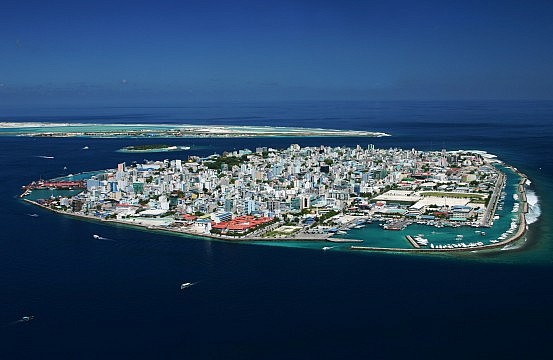
On August 13, 2020, India announced $500 million ‘line of credit’ (LoC) to build bridges and causeways in the Maldives. Media interpreted this economic engagement between the two countries as India’s endeavour to counter growing Chinese influence in the Indian Ocean. This may be true to some extent given the changing strategic and security architecture within the Indian Ocean amidst China’s ever-growing aspirations and activities in the maritime region, across Indo-Pacific and Indian Ocean. India too aspire to broaden its influence across the Maritime region. Hence, a conflict of interests is bound to be there. China’s growing incidence in the said region has serious strategic threat for India. Hence, India need to take stock of the things and strengthen bilateral engagement accordingly.
China’s Growing Influence in Indian Ocean:
Maldives is an Indian Ocean island nation of 340,000 people and 1,192 islands. It is located on major East-West shipping lanes. It is quite popular for its beaches and turquoise waters among tourists. It is also the focal point of China’s Belt and Road Initiative (BRI). Maritime Silk Road (MSR) is an arm of BRI. China looks at Maldives an important destination and link of MSR which aims to build trade and transport links across the Indian Ocean region.
China has been providing unsustainable debts while expanding its sphere of influence in South Asia in particular and Asia in general. China has gradually entered into economic engagement on massive scale with Sri Lanka and Maldives in the Indian Ocean. Maldives, during former regime of President Abdulla Yameen, incurred a huge debt of dollars from China and engaged Chinese firms for infrastructure projects. India and the West are wary of Chinese unbridled growing influence across the maritime region. On the other hand, given India’s interest in the region, India too has been pro-active with both these countries to keep them economically engaged rather than leaving the turf wide open of exclusive interventions of China. Thus, the August 13 announcement must be seen in wider perspective.
India’s Engagement with Maldives:
With this announcement India’s total pledged outlay goes to over $2 billion since President Ibrahim Solih came to power in 2018. Reportedly, India has also pledged $250 million to meet urgent need and support efforts to contain spread of Corona virus pandemic. The Pandemic has taken a huge toll on its tourism industry which is the backbone of its economy.
The development initiatives with Maldives is divided into big projects and small grant projects. The projects under LoC (Line of Credit) is for the long-term infrastructural development in Maldives whereas the small grant projects are created for immediate impact on the community.
High Impact Community Development Projects – These projects involve a total grant assistance of MVR 85 million to Maldives. The high impact community development projects are those which are essential for the welfare of community. In December 2019, India and Maldives have signed a bilateral pact on HICDP in which India had agreed to grant $5.6 million for the implementation of the project and $7 million for execution of small projects. All these projects are to create livelihood, income, education, child empowerment, gender, sports, and sustainable development as well as setting up of various fish processing plants and eco-tourism projects.
Eco tourism projects – As a part of the ‘neighbourhood first’ policy of India, India has also provided a grant assistance for the development of five eco-tourism zones in Addu toll of island nation. These projects are also included within the High Impact Community Development Scheme and the contract award ceremony of the project has already been launched. It involves the grant assistance of $ 5 million. The project will also facilitate the development of local economy.
Travel Bubble with Maldives: Since international travel is prohibited owing to COVID-19 pandemic, the regular travellers have been facing tremendous problems commuting within South Asian countries also. India, thus has singed Air Bubble agreements with many countries. Maldives is the first country that has been facilitated. It will be a great boost to the tourism sector and enhance the revenue of Maldives which has been badly hit by pandemic. This will also facilitate other sectors simultaneously such as employment, transport and emergency medical facilities. In 2019, 1,67,000 Indian tourists visited Maldives which reflects a rise of more than 100 percent since 2018. Therefore, the Agreement will enhance the economic prospects of Maldives.
Direct Ferry Service: In 2019, India and Maldives had signed MOU on Passenger and Cargo services between Kochi in India and Male/Kulhudhuffushi in Maldives. The objective was to improve the economic and cultural ties between the two nations. It is also an alternate and less expensive mode of transport and will facilitate tourism between both the countries. It will also enhance sea connectivity and improve the supplies for importers in Maldives and exporters in India. Overall, the projects will enhance the trade, connectivity and will boost the economic partnership between both the nations.
Submarine Cable for telecom connectivity: This project comes under the $500 million package that has been announced to Maldives. The submarine cable is also set to be renewed between India and Maldives. It is one of the largest infrastructure projects in Maldives which will link Male with Gulhifalhu and Thilafushi islands. This will have a huge impact on the telecommunication sector of Maldives.
Greater Male connectivity Project: Ibrahim Solih had personally sought the assistance for the project. It will be the largest civilian infrastructure project in Maldives connecting Male with the three neighbouring islands- Villingili, Gulhifahu (where a port is being built under Indian LoC), and Thilafushi (new industrial zone) by the construction of bridge and causeway link spanning 6.7 km. The project will be funded with US $400 million LoC along with the previous LoC of $800 million which has been announced in 2018. According to reports, once completed the bridge will be three times longer than the $200-million “China-Maldives Friendship Bridge” completed during Yameen with Chinese loans which has since been re-named. This project is also aimed at increasing: the connectivity between four islands; economic activity within Maldives; employment opportunities for Maldivians; and development of the region.
National Knowledge Network: National Knowledge Network is a project to connect all the educational institutes in India. The other SAARC countries have also been included in the project except Pakistan. This will help the students in all the countries to get an access to the digital library and networking sources. This will enhance engagement and cooperation in the educational sector.
Supply of Essential Commodities: The bilateral trade agreement between India and Maldives was signed in 1981 which provides for the export of essential commodities to Maldives. The trade between India and Maldives had declined substantially which is again being revived. This will include the supply of essential commodities such as potatoes, onion, rice, wheat, flour, sugar, dal, eggs, sand and stone aggregates to Maldives in 2020-2021.
India’s Aspirations in Indian Ocean:
India is the major stakeholder in the Indian Ocean region. Hence India has been seeking to regain diplomatic influence in the states that are littoral in Indian Ocean. Maldives thus acquires a great strategic significance in India’s aspiration at sea and the lanes of communications through the entire maritime region. Resource sharing on sea and on the sea-bed is another area where-in India will need the strong support of maritime neighbours and they can help India by not allowing Chinese foothold on their land. India thus has great challenge in the making within Indian Ocean, at the hands of China. Therefore, it has no choice but to remain highly pro-active and engage the littoral states constructively with itself in a multi-dimensional framework. This will certainly facilitate enhanced security and strategic concerns of India.
Conclusion:
India’s August 13 initiative should be understood more in tune with India’s “Neighbourhood First” policy which has been responded by Maldives’ “India-first Policy”. The fact of India-Maldives bilateral relations is that ever since Solih has come to power the engagement has been enhancing. Even, in spite of the COVID-19 pandemic, bilateral relations between India and Maldives has continued and India has stood by Maldives.
Maldives being an important ally and for its strategic importance it continues to be one of the foreign policy priorities. Some projects have already been inaugurated some are in the process of implementation and some are still in pipeline. The projects that are underway with Maldives has penetrated into diverse sectors such as trade, tourism, investment, increasing people-to-people contact. Some are also being created for increasing the assets for the local community, enhancing employment opportunities and increasing the revenue and exports. Hence, the growing dynamism in economic partnership ensures that the bilateral relations between India and Maldives are multi-sectoral by now.
Regional geopolitics is a victim of India and China rivalry within the region. Maldives need to cautious of China’s debt-trap diplomacy and the predator-nature of its BRI. India needs to be aware of the structural and economic problems Maldives is facing in the present times. The first and the foremost thing is to remain true to the promises that are being made to regain the confidence in the neighbours. It has to ensure the proper implementation of the collaborative projects that have been formulated. This will certainly build strong image of India before its neighbours.
Courtesy: First published on www.southasiaanalysis.org





A quite detailed view about our collaboration with Maldives, our next door neighbour in the IOR, so strategically important for us and for maintaining peace and tranquility in the region. India needs consistent efforts on to help and sustain growth and goodwill of our neighbours and be first to reach to their population in case of any God forbidden calamity.